Europe, British Isles, North-East England, Northumberland, Alnwick Region
Alnwick Region is in Northumberland.
Europe, British Isles, North-East England, Northumberland, Alnwick Region, Allendale Town [Map]
The River East Allen rises near Allenheads [Map] from where it flows past Ropehaugh [Map], Spartylea [Map], Sinderhope [Map], Allendale Town [Map], Catton [Map] to just before Cupola Bridge [Map] where it converges with the River West Allen to form the River Allen.
Europe, British Isles, North-East England, Northumberland, Alnwick Region, Allenheads [Map]
The River East Allen rises near Allenheads [Map] from where it flows past Ropehaugh [Map], Spartylea [Map], Sinderhope [Map], Allendale Town [Map], Catton [Map] to just before Cupola Bridge [Map] where it converges with the River West Allen to form the River Allen.
Europe, British Isles, North-East England, Northumberland, Alnwick Region, Amble [Map]
The River Coquet rises around Chew Green [Map] from where it flows past Makendon Northumberland [Map], Blindburn [Map], Barrow Burn [Map], Shillmoor [Map], Linshiels [Map], Alwinton [Map], Harbottle Castle [Map], Sharperton [Map], Holystone [Map], Hepple [Map], Thropton [Map], Rothbury [Map], Pauperhaugh [Map], Brinkburn Priory [Map], Weldon Bridge [Map], Felton [Map], Guyzance [Map] before passing under the bridge at Warkworth Bridge [Map] and reaching the North Sea at Amble [Map].
Europe, British Isles, North-East England, Northumberland, Alnwick Region, Bamburgh [Map]
In 1849 John Charlton was born to Samuel Charlton at Bamburgh [Map].
Bede. To give one instance, it is told, that when he was once sitting at dinner, on the holy day of Easter, with the aforesaid bishop, and a silver dish full of royal dainties was set before him, and they were just about to put forth their hands to bless the bread, the servant, whom he had appointed to relieve the needy, came in on a sudden, and told the king, that a great multitude of poor folk from all parts was sitting in the streets begging alms of the king; he immediately ordered the meat set before him to be carried to the poor, and the dish to be broken in pieces and divided among them. At which sight, the bishop who sat by him, greatly rejoicing at such an act of piety, clasped his right hand and said, "May this hand never decay." This fell out according to his prayer, for his hands with the arms being cut off from his body, when he was slain in battle, remain uncorrupted to this day, and are kept in a silver shrine, as revered relics, in St. Peter's church in the royal city314, which has taken its name from Bebba, one of its former queens. Through this king's exertions the provinces of the Deiri and the Bernicians, which till then had been at variance, were peacefully united and moulded into one people. He was nephew to King Edwin through his sister Acha; and it was fit that so great a predecessor should have in his own family such an one to succeed him in his religion and sovereignty.
Note 314. Bamborough [Map] (Bebbanburh, Bebburgh, Babbanburch, etc. There are many forms of the name). It is uncertain who the queen was. Nennius says she was the wife of Ethelfrid. His wife, Oswald's mother, was Acha (v. infra), but he may have been married twice. It was Ida, the first king of Bernicia, who founded Bamborough (Sax. Chron.).
Europe, British Isles, North-East England, Northumberland, Alnwick Region, Bamburgh, Farne Islands [Map]
Bede. How Ethelwald successor to Cuthbert leading a hermit's life calmed a tempest by his prayers when the brethren were in danger at sea. [687 699 a.d.]
The venerable Ethelwald succeeded the man of God, Cuthbert, in the exercise of a solitary life, which he spent in the isle of Farne [Map] before he became a bishop. After he had received the priesthood, he consecrated his office by deeds worthy of that degree for many years in the monastery which is called Inhrypum. To the end that his merit and manner of life may be the more certainly made known, I will relate one miracle of his, which was told me by one of the brothers for and on whom the same was wrought; to wit, Guthfrid-, the venerable servant and priest of Christ, who also, afterwards, as abbot, presided over the brethren of the same church of Lindisfarne [Map], in which he was educated.
"I came," says he, "to the island of Farne [Map], with two others of the brethren, desiring to speak with the most reverend father, Ethelwald. Having been refreshed with his discourse, and asked for his blessing, as we were returning home, behold on a sudden, when we were in the midst of the sea, the fair weather in which we were sailing, was broken, and there arose so great and terrible a tempest, that neither sails nor oars were of any use to us, nor had we anything to expect but death. After long struggling with the wind and waves to no effect, at last we looked back to see whether it was possible by any means at least to return to the island whence we came, but we found that we were on all sides alike cut off by the storm, and that there was no hope of escape by our own efforts. But looking further, we perceived, on the island of Farne, our father Ethelwald, beloved of God, come out of his retreat to watch our course; for, hearing the noise of the tempest and raging sea, he had come forth to see what would become of us. When he beheld us in distress and despair, he bowed his knees to the Father of our Lord Jesus Christ, in prayer for our life and safety; and as he finished his prayer, he calmed the swelling water, in such sort that the fierceness of the storm ceased on all sides, and fair winds attended us over a smooth sea to the very shore. When we had landed, and had pulled up our small vessel from the waves, the storm, which had ceased a short time for our sake, presently returned, and raged furiously during the whole day; so that it plainly appeared that the brief interval of calm had been granted by Heaven in answer to the prayers of the man of God, to the end that we might escape.".
The man of God remained in the isle of Farne [Map] twelve years, and died there; but was buried in the church of the blessed Apostle Peter [Map], in the isle of Lindisfarne, beside the bodies of the aforesaid bishops. These things happened in the days of King Aldfrid, who, after his brother Egfrid, ruled the nation of the Northumbrians for nineteen years.
Europe, British Isles, North-East England, Northumberland, Alnwick Region, Bamburgh, St Aidan's Church [Map]
Around 1623 Claudius Forster 1st Baronet (age 48) died without issue at Blanchland Abbey [Map]. He was buried at St Aidan's Church, Bamburgh [Map]. Baronet Forster of Bamburgh extinct. His brother John Forster (age 46) inherited his estates including Blanchland Abbey [Map].
In Oct 1738 General Thomas Forster of Adderstone (age 55) died unmarried. He was buried at St Aidan's Church, Bamburgh [Map].
Europe, British Isles, North-East England, Northumberland, Alnwick Region, Barrow Burn [Map]
The River Coquet rises around Chew Green [Map] from where it flows past Makendon Northumberland [Map], Blindburn [Map], Barrow Burn [Map], Shillmoor [Map], Linshiels [Map], Alwinton [Map], Harbottle Castle [Map], Sharperton [Map], Holystone [Map], Hepple [Map], Thropton [Map], Rothbury [Map], Pauperhaugh [Map], Brinkburn Priory [Map], Weldon Bridge [Map], Felton [Map], Guyzance [Map] before passing under the bridge at Warkworth Bridge [Map] and reaching the North Sea at Amble [Map].
Europe, British Isles, North-East England, Northumberland, Alnwick Region, Beadnell
Europe, British Isles, North-East England, Northumberland, Alnwick Region, Blindburn [Map]
On 14 Feb 1874 Elizabeth Clayton (age 37) died at Blindburn [Map].
On 19 Oct 1906 Major-General George Allgood (age 78) died at Blindburn [Map].
On 26 May 1920 Adrian George Allgood (age 52) died suddenly at Blindburn [Map].
The River Coquet rises around Chew Green [Map] from where it flows past Makendon Northumberland [Map], Blindburn [Map], Barrow Burn [Map], Shillmoor [Map], Linshiels [Map], Alwinton [Map], Harbottle Castle [Map], Sharperton [Map], Holystone [Map], Hepple [Map], Thropton [Map], Rothbury [Map], Pauperhaugh [Map], Brinkburn Priory [Map], Weldon Bridge [Map], Felton [Map], Guyzance [Map] before passing under the bridge at Warkworth Bridge [Map] and reaching the North Sea at Amble [Map].
Europe, British Isles, North-East England, Northumberland, Alnwick Region, Bolton [Map]
The River Aln rises near Alnham [Map] from where it flows past Whittingham [Map], Bolton [Map], Hulne Priory [Map] then passing around Alnwick Castle [Map] before passing Lesbury [Map] then at Alnwick, Northumberland [Map] it joins the North Sea.
Europe, British Isles, North-East England, Northumberland, Alnwick Region, Bolton Church [Map]
Bolton Church [Map]. Arms of Martha Burrill, d.1700, on south of chancel; similar painted coat of arms on north of nave. Several C18 and C19 wall tablets, including monument to Forster family (1790-1809), with draped urn, signed by R. Blore, and 1864 tablet to Lewis de Crespigny Buckle, who perished at sea on the S.S. Nemesis.
On 28 Oct 1914 John Mounsey Lambert (age 31) was killed in action during an unsuccessful attack on the village of Neuve Chapelle. He is commemorated on a plaque at Bolton Church [Map].
Europe, British Isles, North-East England, Northumberland, Alnwick Region, Bolton Hall [Map]
In 1898 Major-General George Lambert died at his home Bolton Hall, Edlingham [Map].
On 24 Apr 1919 Major Dudley Francis De Crespigny Buckle (age 42) died from wounds at the Bolton Hall, Edlingham [Map]; the home of his father-in-law Major-General George Lambert. He was buried at St John the Baptist Church, Edlingham [Map].
Europe, British Isles, North-East England, Northumberland, Alnwick Region, Brinkburn
Europe, British Isles, North-East England, Northumberland, Alnwick Region, Brinkburn Priory House [Map]
Brinkburn Priory House [Map] is the south range of Priory conventual buildings converted into house for Fenwick family in later C16, remodelled 1810 for Richard Hodgson; alterations and major extensions 1830-37 by John Dobson for William Hodgson Cadogan.
William Hodgson Cadogan: Around 1796 he was born. In 1855 he died.
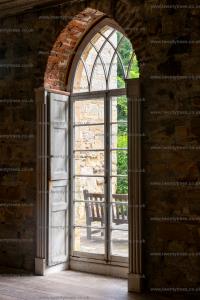
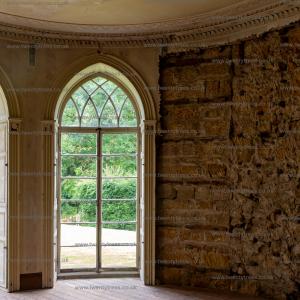
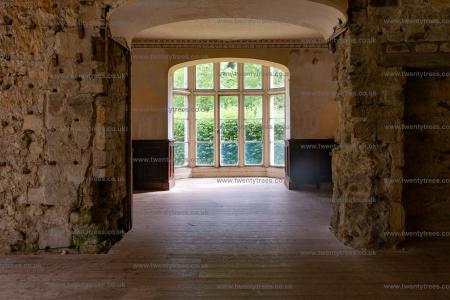
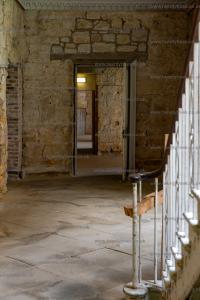
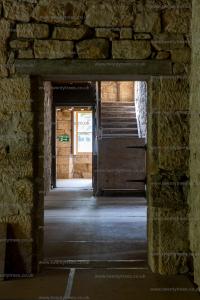
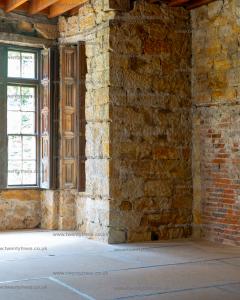
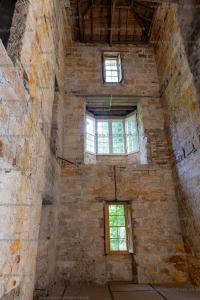
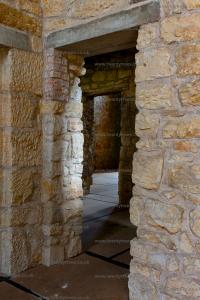
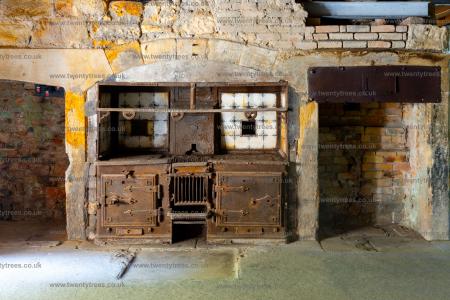
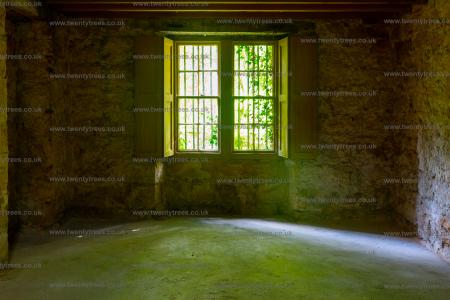
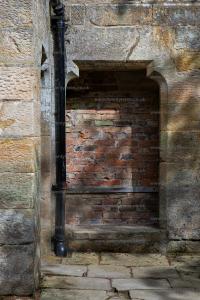
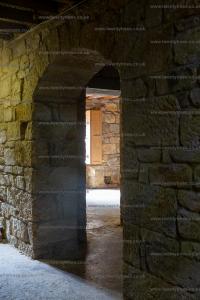
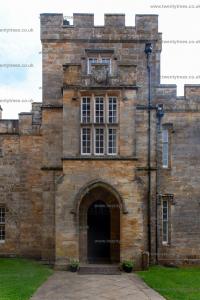
Europe, British Isles, North-East England, Northumberland, Alnwick Region, Craster [Map]
In 1906 a plaque was placed on Craster [Map] Harbour recognising the contribution made in its construction by Captain John Charles Pulleine Craster.
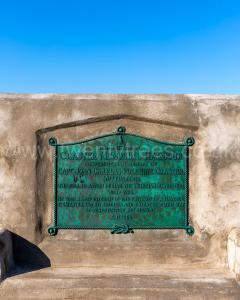
Europe, British Isles, North-East England, Northumberland, Alnwick Region, Craster Tower
On 04 Sep 1781 John Wood of Beadnell in Northumberland (age 38) and Ann Craster (age 21) were married. She the eventual heir of her father inherited Craster Tower. Her son adopted the surname Craster. They were third cousins.
On 18 Nov 1828 John Wood of Beadnell in Northumberland (age 85) died. Thomas Wood aka Craster (age 42) inherited Craster Tower.
Dunstanburgh Castle
Between 1313 and 1322 Dunstanburgh Castle [Map] was constructed on behalf of Thomas Plantagenet 2nd Earl of Leicester, 2nd Earl Lancaster, Earl of Salisbury and Lincoln (age 35) when Thomas was in revolt against his cousin King Edward II of England (age 28). The castle is visible from the Royal Bamburgh Castle [Map] and may have sited deliberately as a challenge to Royal authority. The Master Mason was Master Elias, possibly Elias de Burton, who had been previously involved in the construction of Conwy Castle in North Wales. In 1316 King Edward II of England (age 28) issued a license to crenellate.
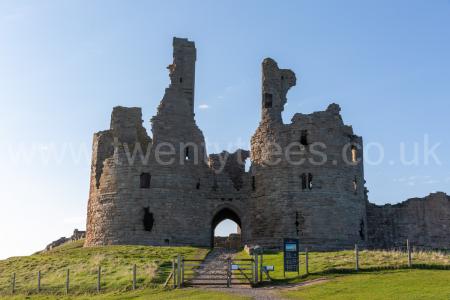
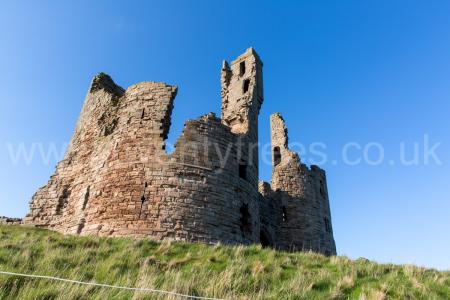
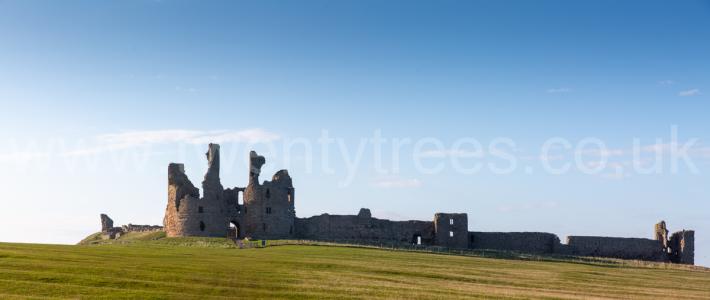
Warkworth's Chronicle 1461. 1462. Also Quene Margrett1, Herry Duke of Excetre (age 31), the Duke of Somersett, and other lordes2 that fleede Englonde, hade kepte certeyne castelles3 in Northumberlond, as Awnwyk [Map], Bambrught [Map], Dunstonebrught [Map], and also Werworthe [Map], whiche they hade vytaled and stuffed bothe with Englischemenne, Frenschemenne, and Scottesmenne, by the whiche castelle, thei hade the moste party of alle Northumberlond.
Note 1. Also Quene Margrett. This was in the year 1462. Towards the end of the year Edward appears to have made a tour to the West of England, perhaps for the purpose of seeing how the country was disposed towards him:- "Deinde Rex Edwardus, Cantuariam peregre profectus, partes meridionales pertransiit, ubi Willielmum Episcopum Wintonie de manibus querentium animam ejus eripuit, insectatores suos graviter redarguit, et eorum capitaneos carcerali custodi emancipavit. Bristollie apperians, a civibus ejus cum maximo gaudio honoratissimè receptus est. [Then King Edward, having journeyed to Canterbury, passed through the southern regions, where he rescued William, Bishop of Winchester, from the hands of those seeking his life, severely rebuked his pursuers, and freed their leaders from prison custody. Upon arriving in Bristol, he was received with the utmost joy and honor by its citizens.]" - MS. Arundel, Coll. Arm. 5, fol. 169, ro. This Chronicle in the College of Arms was first used, as far as I know, for an historical purpose, in a MS. note in a copy of Carte's History of England in the Bodleian Library, where it is referred to on the important testimony of the death of Henry VI. Mr. Black quotes it in the Excerpta Historica, but its value does not appear to be fully appreciated by that author; it is the diary of a contemporary writer on the side of the House of York, and extends to the execution of the Bastard of Fauconberg, and Edward's celebration of the feast of Pentecost which took place immediately afterwards.
The following very curious account of the pageant which received Edward at Bristol is from a MS. in Lambeth Palace, No. 306, fol. 132, ro. I am indebted for it to the Rev. S. R. Maitland, F.R.S., Librarian to the Archbishop of Canterbury, who had the extreme kindness, at my request, to send me a transcript.
"The receyvyng of Kyng Edward the iiijth, at Brystowe.
"First, at the comyng inne atte temple gate, there stode Wylliam Conquerour, with iij. lordis, and these were his wordis:
'Wellcome Edwarde! oure son of high degre;
Many yeeris hast thou lakkyd owte of this londe-
I am thy forefader, Wylliam of Normandye,
To see thy welefare here through Goddys sond. '
"Over the same gate stondyng a greet Gyant delyveryng the keyes.
"The Receyvyng atte Temple Crosse next following;
" There was Seynt George on horsbakke, uppon a tent, fyghtyng with a dragon; and the Kyng and the Quene on hygh in a castell, and his doughter benethe with a lambe; and atte the sleying of the dragon ther was a greet melody of aungellys."
09 Sep 1461. Sir Bawdan (or Baldwin) Fulford was brought before the King, and beheaded at this place on the ninth of September; his head was placed upon Castle Gate. - Rot. C. 8. Mus. Brit.
Note 2. And other lordes. Among them was Thomas Lord Roos (age 34). Paston Correspondence, vol. I. p. 219.
Note 3. Certeyne castelles in Northumberlond. See two contemporary accounts of the sieges of these castles, edited by Mr. Black, in the Excerpta Historica, p. 365.
Chronicle of Gregory 1462. Jul 1462. Thys yere Quene Margarete (age 32) com owt of Frauns with lij [52] schyppys, with Freynysche men and sum Engelysche men in the schyppys. And they londyd in Northe Humberlonde, hyt was vij dayes be-fore Alle Halwyn tyde. And there sche toke the castelle of Anwyke [Map] and put hyt fulle of Fraynyschemen. And thenn she retornyd in to Schotlonde by water. And there rosse suche a tempaste uppon hyr that she for soke hyr schippe, and a schapyd with the bote of þe schyppe. And the schyppe was drownyd with moche of hyr stuffe and iij [3] grete schippys moo. And iiij c and vj [406] Fraynysche men were take in the chyrche of Hooly Ylond [Map]. Thenn Kyng Edward (age 20) hyrde telle of thys, and made hym redy towarde the Northe with many lordys, gentellys, and comyns with hym. And there he layde a sege to Anwyke Castelle [Map], and to the castelle of Bamborowe [Map], and to Dunsterborowe [Map]. Bamborowe [Map] and Dunsterborowe [Map] was kepte by Syr Raffe Persy (age 37) and Syr Harry Bewforde (age 26), late Duke of Somersett, and the castelle of Anwyke [Map] with the Lorde Hungerforde (age 31). And Bamborowe [Map] and Dunsterborowe [Map] were yoldyn be Syr Raffe Percy (age 37) and Syr Harry Beuford (age 26), late Duke of Somersett, to the Kyngys wylle, whythe the condyscyons that the sayde Raffe Percy (age 37) schulde have the kepynge of the ij castellys, Bamborowe [Map] and Dunstarborowe [Map]. The sayde Syr Raffe Percy (age 37) and Syr Harry Beuforde (age 26), late Duke of Somersett, were sworne to be trewe and faythefulle as trewe lege men unto owre kynge and soverayne lorde Edwarde the iiijthe (age 20). And they com to Derham [Map], and there they were sworne byfore owre kynge. And the kynge gaffe hem hys levery and grete rewardys. See 1464 Suppressing the Lancastrian Northern Resistance.



Chronicle of Gregory 1464. Around Jul 1464. Alle so the same somer my Lorde of Warwycke (age 35) and hys brether the Lorde Mountegewe (age 33), that was made Erle of Northehumberlond by the kynge, they ij layde a sege unto the castelle of Anwyke [Map] a gate hyt by a-poyntement. And in the same wyse and forme they gate the castelle of Dunsterborowe [Map] by the same mene. And thenne they layd sege to the castelle of Bamborowe [Map], and layde grete ordynans and gonnys [Note. guns] there too. And manly they gate hyt by fors, and toke there yn that fals traytur Syr Raffe Gray (age 32), and brought hym unto the kynge to the castelle of Pomfrete [Map]. And fro thens he was ladde to Dankester [Map], and there hys hedde was smete of and sent to London, and hyt was sette a-pon Londyn Bryge [Map].

Europe, British Isles, North-East England, Northumberland, Alnwick Region, East Horton [Map]
The Devil's Causeway is a Roman Road from the Portgate [Map], where it crossed Dere Street, to Berwick on Tweed [Map]. It passes through Great Whittingham [Map], Hartburn [Map], where it crosses the Hart Burn, Netherwitton [Map], Longhorsley [Map], Brinkburn Priory [Map], whereit crosses the River Coquet, north of North End [Map], Edlingham [Map] to Learchild Roman Fort [Map] where another road headed west to meet Dere Street at Bremenium [Map] aka High Rochester. The road then continues north passing Glanton [Map], Powburn [Map], where it crosses the River Till aka Breamish, the site of the Battle of Hedgeley Moor [Map], Newtown [Map], East Horton [Map], Lowick [Map], Berrington [Map] before reaching Berwick on Tweed [Map].
Europe, British Isles, North-East England, Northumberland, Alnwick Region, East Woodburn [Map]
The River Rede rises near the border of Scotland and England by the Carter Bar Boundary Marker [Map] from where it flows past Catcleugh, Northamptonshire [Map], Cottonshopeburnfoot [Map], Rochester [Map] near the Bremenium [Map] Roman Fort, past Horsley [Map], Elishaw [Map], past Percy's Cross at the Site of the Battle of Otterburn [Map], Otterburn [Map], East and West Woodburn [Map] to Redesmouth [Map] where it joins the River North Tyne.
Europe, British Isles, North-East England, Northumberland, Alnwick Region, Edlingham [Map]
On 26 Feb 1893 Reverend Matthew Hughes George Buckle (age 90) died at Edlingham [Map]. He was buried St John the Baptist Church, Edlingham [Map].
The Devil's Causeway is a Roman Road from the Portgate [Map], where it crossed Dere Street, to Berwick on Tweed [Map]. It passes through Great Whittingham [Map], Hartburn [Map], where it crosses the Hart Burn, Netherwitton [Map], Longhorsley [Map], Brinkburn Priory [Map], whereit crosses the River Coquet, north of North End [Map], Edlingham [Map] to Learchild Roman Fort [Map] where another road headed west to meet Dere Street at Bremenium [Map] aka High Rochester. The road then continues north passing Glanton [Map], Powburn [Map], where it crosses the River Till aka Breamish, the site of the Battle of Hedgeley Moor [Map], Newtown [Map], East Horton [Map], Lowick [Map], Berrington [Map] before reaching Berwick on Tweed [Map].
Europe, British Isles, North-East England, Northumberland, Alnwick Region, Edlingham, St John the Baptist Church [Map]
In or before 1841 Reverend Matthew Hughes George Buckle (age 38) was appointed Vicar of St John the Baptist Church, Edlingham [Map].
On 24 Apr 1919 Major Dudley Francis De Crespigny Buckle (age 42) died from wounds at the Bolton Hall, Edlingham [Map]; the home of his father-in-law Major-General George Lambert. He was buried at St John the Baptist Church, Edlingham [Map].
Europe, British Isles, North-East England, Northumberland, Alnwick Region, Eglingham
Europe, British Isles, North-East England, Northumberland, Alnwick Region, St Maurice's Church Eglingham [Map]
St Maurice's Church Eglingham [Map]. On the wall is a brass plaque commemorating Captain John Carr-Ellison who fought in the Crimean War and later served as High Sheriff of Durham. Eglingham church is normally open daylight hours and was open when we visited.
Under the sanctuary is the Collingwood family vault, and hidden under the carpet is a memorial to Ralph Collingwood of East Ditchburn, who died in 1648, and his son Cuthbert (d 1687). Ralph was a direct ancestor of Lord Cuthbert Collingwood, a naval commander who was second in command to Admiral Nelson at the Battle of Trafalgar in 1805.
.
Europe, British Isles, North-East England, Northumberland, Alnwick Region, Embleton
Europe, British Isles, North-East England, Northumberland, Alnwick Region, Fallodon
Europe, British Isles, North-East England, Northumberland, Alnwick Region, Fallodon Hall [Map]
On 10 Oct 1767 George Grey 1st Baronet was born to Charles Grey 1st Earl Grey (age 37) and Elizabeth Grey Countess Grey (age 23) at Fallodon Hall [Map].
On 09 Mar 1865 Alice Emma Grey was born to Lieutenant Colonel George Henry Grey (age 29) and Harriet Jane Pearson (age 26) at Fallodon Hall [Map].
On 14 Jul 1866 George Grey was born to Lieutenant Colonel George Henry Grey (age 31) and Harriet Jane Pearson (age 27) at Fallodon Hall [Map].
On 29 Oct 1868 Jane Grey was born to Lieutenant Colonel George Henry Grey (age 33) and Harriet Jane Pearson (age 29) at Fallodon Hall [Map].
On 10 Jun 1870 Alexander Harry Grey was born to Lieutenant Colonel George Henry Grey (age 35) and Harriet Jane Pearson (age 31) at Fallodon Hall [Map].
On 23 Aug 1873 Charles Grey was born to Lieutenant Colonel George Henry Grey (age 38) and Harriet Jane Pearson (age 34) at Fallodon Hall [Map].
Europe, British Isles, North-East England, Northumberland, Alnwick Region, Felton [Map]
The River Coquet rises around Chew Green [Map] from where it flows past Makendon Northumberland [Map], Blindburn [Map], Barrow Burn [Map], Shillmoor [Map], Linshiels [Map], Alwinton [Map], Harbottle Castle [Map], Sharperton [Map], Holystone [Map], Hepple [Map], Thropton [Map], Rothbury [Map], Pauperhaugh [Map], Brinkburn Priory [Map], Weldon Bridge [Map], Felton [Map], Guyzance [Map] before passing under the bridge at Warkworth Bridge [Map] and reaching the North Sea at Amble [Map].
Europe, British Isles, North-East England, Northumberland, Alnwick Region, Glanton [Map]
The Devil's Causeway is a Roman Road from the Portgate [Map], where it crossed Dere Street, to Berwick on Tweed [Map]. It passes through Great Whittingham [Map], Hartburn [Map], where it crosses the Hart Burn, Netherwitton [Map], Longhorsley [Map], Brinkburn Priory [Map], whereit crosses the River Coquet, north of North End [Map], Edlingham [Map] to Learchild Roman Fort [Map] where another road headed west to meet Dere Street at Bremenium [Map] aka High Rochester. The road then continues north passing Glanton [Map], Powburn [Map], where it crosses the River Till aka Breamish, the site of the Battle of Hedgeley Moor [Map], Newtown [Map], East Horton [Map], Lowick [Map], Berrington [Map] before reaching Berwick on Tweed [Map].
Europe, British Isles, North-East England, Northumberland, Alnwick Region, Glanton, Hedgeley Moor [Map]
On 25 Apr 1464 a Yorkist army commanded by John Neville 1st Marquess Montagu (age 33) defeated a Lancastrian army commanded by Henry Beaufort 2nd or 3rd Duke Somerset (age 28) at Hedgeley Moor [Map] during the Battle of Hedgeley Moor.

Of the Lancastrians ...
Thomas Ros 9th Baron Ros Helmsley (age 36) was killed. His son Edmund Ros 10th Baron Ros Helmsley (age 9) succeeded 10th Baron Ros Helmsley. Thomas' lands however, including Belvoir Castle [Map] was given by King Edward IV of England (age 21) to William Hastings 1st Baron Hastings (age 33).


Ralph Percy (age 39) was killed.
Edmund Ros 10th Baron Ros Helmsley: Around 1455 he was born to Thomas Ros 9th Baron Ros Helmsley and Philippa Tiptoft Baroness Ros Helmsley. On 23 Oct 1508 Edmund Ros 10th Baron Ros Helmsley died. Baron Ros Helmsley abeyant between his daughters.
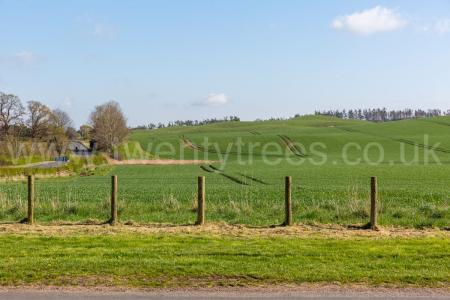
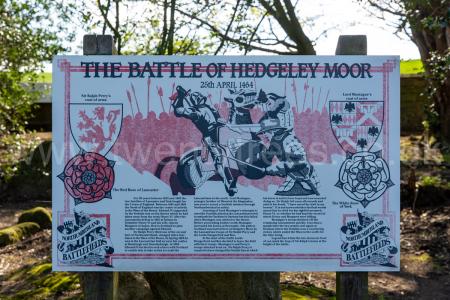
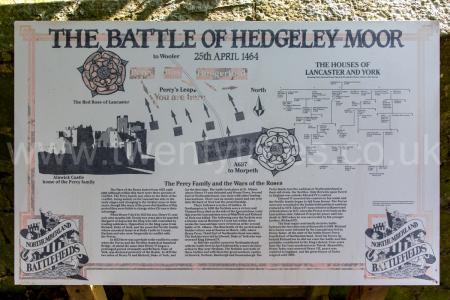
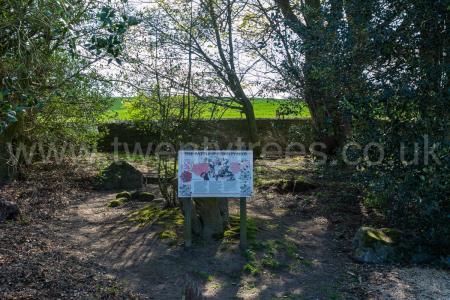
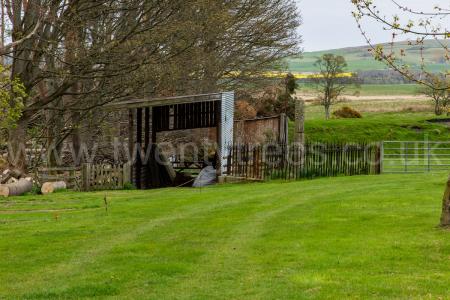
The Devil's Causeway is a Roman Road from the Portgate [Map], where it crossed Dere Street, to Berwick on Tweed [Map]. It passes through Great Whittingham [Map], Hartburn [Map], where it crosses the Hart Burn, Netherwitton [Map], Longhorsley [Map], Brinkburn Priory [Map], whereit crosses the River Coquet, north of North End [Map], Edlingham [Map] to Learchild Roman Fort [Map] where another road headed west to meet Dere Street at Bremenium [Map] aka High Rochester. The road then continues north passing Glanton [Map], Powburn [Map], where it crosses the River Till aka Breamish, the site of the Battle of Hedgeley Moor [Map], Newtown [Map], East Horton [Map], Lowick [Map], Berrington [Map] before reaching Berwick on Tweed [Map].
Europe, British Isles, North-East England, Northumberland, Alnwick Region, Guyzance [Map]
The River Coquet rises around Chew Green [Map] from where it flows past Makendon Northumberland [Map], Blindburn [Map], Barrow Burn [Map], Shillmoor [Map], Linshiels [Map], Alwinton [Map], Harbottle Castle [Map], Sharperton [Map], Holystone [Map], Hepple [Map], Thropton [Map], Rothbury [Map], Pauperhaugh [Map], Brinkburn Priory [Map], Weldon Bridge [Map], Felton [Map], Guyzance [Map] before passing under the bridge at Warkworth Bridge [Map] and reaching the North Sea at Amble [Map].
Europe, British Isles, North-East England, Northumberland, Alnwick Region, Hepple [Map]
The River Coquet rises around Chew Green [Map] from where it flows past Makendon Northumberland [Map], Blindburn [Map], Barrow Burn [Map], Shillmoor [Map], Linshiels [Map], Alwinton [Map], Harbottle Castle [Map], Sharperton [Map], Holystone [Map], Hepple [Map], Thropton [Map], Rothbury [Map], Pauperhaugh [Map], Brinkburn Priory [Map], Weldon Bridge [Map], Felton [Map], Guyzance [Map] before passing under the bridge at Warkworth Bridge [Map] and reaching the North Sea at Amble [Map].
Europe, British Isles, North-East England, Northumberland, Alnwick Region, Holystone [Map]
The River Coquet rises around Chew Green [Map] from where it flows past Makendon Northumberland [Map], Blindburn [Map], Barrow Burn [Map], Shillmoor [Map], Linshiels [Map], Alwinton [Map], Harbottle Castle [Map], Sharperton [Map], Holystone [Map], Hepple [Map], Thropton [Map], Rothbury [Map], Pauperhaugh [Map], Brinkburn Priory [Map], Weldon Bridge [Map], Felton [Map], Guyzance [Map] before passing under the bridge at Warkworth Bridge [Map] and reaching the North Sea at Amble [Map].
Europe, British Isles, North-East England, Northumberland, Alnwick Region, Holystone, Lady's Well [Map]
Lady's Well [Map] was once a watering place beside a Roman Road from Bremenium in Redesdale to the coast. Reconstructed in 1788 when statue brought from Alnwick Castle erected in centre of tank. Statue moved to south of well in 19th Century and replaced with Ceeltic Cross. Statue fell over in the storms of Nov 2021. Possibly scene of mass conversions by Archbishop Paulinus of York on Easter Day A.D. 627, more likely preaching place of St Ninian.
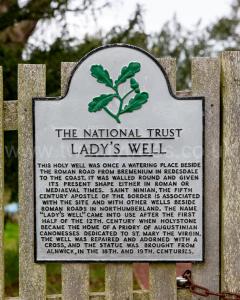
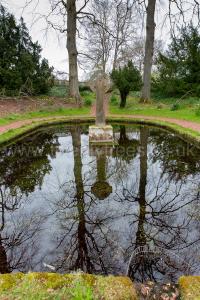
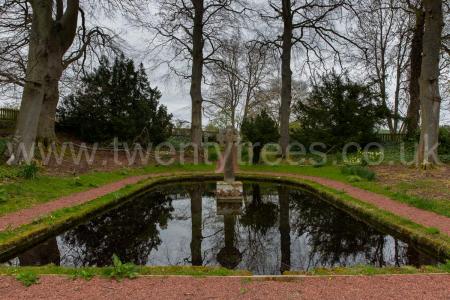
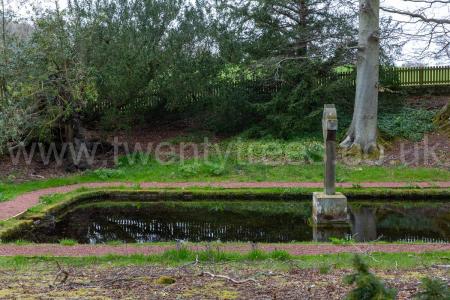
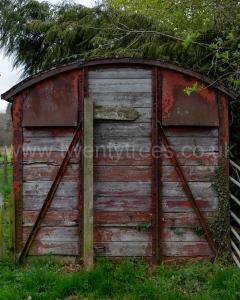
Europe, British Isles, North-East England, Northumberland, Alnwick Region, Homildon Hill [Map]
On 14 Sep 1402 Henry Percy 1st Earl of Northumberland (age 60) and his son Henry "Hotspur" Percy (age 38) lay in wait at Homildon Hill [Map] for the Scots to return from their laying waste to Northumberland. The Battle of Homildon Hill was a victory for the English forces whose longbowmen decimated the Scottish schiltrons. Henry Fitzhugh 3rd Baron Fitzhugh (age 44) fought for the English.
John Swinton was killed.
Thomas Dunbar 2nd Earl Moray (age 31) and Henry Sinclair 2nd Earl Orkney (age 27) were captured.
Archibald Douglas 1st Duke Touraine (age 30) was wounded. King Henry IV of England (age 35) forbade the ransoming of Scottish prisoners so that he could concentrate on the Welsh. By doing so he created a rift with the Percy family who subsequently defected to Owain ap Gruffudd Glyndŵr (age 43).
William Stewart of Jedworth and Teviotdale (age 46) was executed by Henry "Hotspur" Percy (age 38) having been captured.
John Stewart 1st of Dalswinton and Garlies (age 32) fought at the Battle of Homildon Hill.
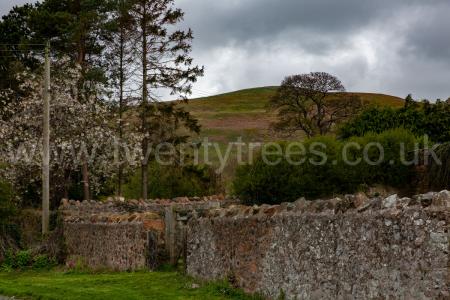

Europe, British Isles, North-East England, Northumberland, Alnwick Region, Horsley [Map]
The River Rede rises near the border of Scotland and England by the Carter Bar Boundary Marker [Map] from where it flows past Catcleugh, Northamptonshire [Map], Cottonshopeburnfoot [Map], Rochester [Map] near the Bremenium [Map] Roman Fort, past Horsley [Map], Elishaw [Map], past Percy's Cross at the Site of the Battle of Otterburn [Map], Otterburn [Map], East and West Woodburn [Map] to Redesmouth [Map] where it joins the River North Tyne.
Horton Castle
On 20 Dec 1292 King Edward I (age 53) stayed at Horton Castle [Map] for one night when returning from adjudicating the claim to the Scottish throne. The landholder, Sir Guiscard de Charron, had used the occasion of Edwards's visit to ask for the necessary permission to fortify his manor house, that Edward was currently a guest in. The license to crenelate was granted one week later in Newcastle.
On 27 Jun 1301 King Edward I (age 62) visited Horton Castle [Map].
Betwee 31 Aug 1304 or 01 Sep 1304 to 06 Sep 1304 King Edward I (age 65) stayed at Horton Castle [Map].
Around 1509 Thomas Grey of Horton was born to Roger Grey of Horton (age 34) and Isabel Darcy (age 40) at Horton Castle [Map].

Around 1531 Ann Grey was born to Thomas Grey of Horton (age 22) and Dorothy Ogle at Horton Castle [Map].
On 11 Jul 1532 Isabel Grey was born to Thomas Grey of Horton (age 23) and Dorothy Ogle at Horton Castle [Map].
On 06 Oct 1581 Isabel Grey (age 49) died at Horton Castle [Map].
Europe, British Isles, North-East England, Northumberland, Alnwick Region, Horton Grange [Map]
The River Blyth rises near Kirkheaton [Map] from where it flows past Bradford [Map], Belsay [Map], Ogle [Map], Kirkley [Map], Horton Grange [Map], Stannington [Map], Bedlington [Map] to Blyth [Map] where it reaches the North Sea.
Europe, British Isles, North-East England, Northumberland, Alnwick Region, Howick
Europe, British Isles, North-East England, Northumberland, Alnwick Region, Howick Hall [Map]
On or before 23 Oct 1729 Charles Grey 1st Earl Grey was born to Henry Grey 1st Baronet (age 37) and Hannah Wood at Howick Hall [Map]. He was baptised on 23 Oct 1729.
On 09 Dec 1816 John "Radical Jack" Lambton 1st Earl Durham (age 24) and Louisa Elizabeth Grey Countess Durham (age 19) were married at Howick Hall [Map]. She the daughter of Charles Grey 2nd Earl Grey (age 52) and Mary Elizabeth Ponsonby Countess Grey (age 40).

Europe, British Isles, North-East England, Northumberland, Alnwick Region, St Michael and All Angels Howick [Map]
After 17 Jul 1845 Charles Grey 2nd Earl Grey (age 81) was buried at St Michael and All Angels Howick [Map].
Europe, British Isles, North-East England, Northumberland, Alnwick Region, Hulne Priory [Map]
The River Aln rises near Alnham [Map] from where it flows past Whittingham [Map], Bolton [Map], Hulne Priory [Map] then passing around Alnwick Castle [Map] before passing Lesbury [Map] then at Alnwick, Northumberland [Map] it joins the North Sea.
Europe, British Isles, North-East England, Northumberland, Alnwick Region, Lindisfarne [Map]
Bede. 565. AD. Columba (age 43) came into Britain in the ninth year of the reign of Bridius, who was the son of Meilochon304, and the powerful king of the Pictish nation, and he converted that nation to the faith of Christ, by his preaching and example. Wherefore he also received of them the gift of the aforesaid island [Map] whereon to found a monastery. It is not a large island, but contains about five families, according to the English computation; his successors hold it to this day; he was also buried therein, having died at the age of seventy-seven, about thirty-two years after he came into Britain to preach305. Before he crossed over into Britain, he had built a famous monastery in Ireland, which, from the great number of oaks, is in the Scottish tongue called Dearmach-The Field of Oaks306. From both these monasteries, many others had their beginning through his disciples, both in Britain and Ireland; but the island monastery where his body lies, has the pre-eminence among them all.
Note 304. Bruide Mac Maelchon had defeated the Dalriadic Scots in 560 a.d. and driven them back to Cantyre. Northwards his dominion extended as far as the Orkneys and it is probable that it included the eastern lowlands north of the Forth (cf. Rhŷs, "Celtic Britain"). Another tradition (Irish) represents Conall, King of the Dalriadic Scots, as the donor of Iona, but the earliest Irish authority (ninth or tenth century) agrees with Bede.
Note 305. The year in which he died, as well as the ultimate resting-place of his relics, is uncertain. Dr. Reeves places his death in 597, the year of St. Augustine's landing.
Note 306. i.e., in Irish. The place is Durrow in Leinster.
Bede. In the fourth year of the reign of Osred (age 12), Coenred, who had for some time nobly governed the kingdom of the Mercians, much more nobly quitted the sceptre of his kingdom. For he went to Rome, Italy, and there receiving the tonsure and becoming a monk, when Constantine (age 45) was pope, he continued to his last hour in prayer and fasting and alms-deeds at the threshold of the Apostles. He was succeeded in the throne by Ceolred, the son of Ethelred, who had governed the kingdom before Coenred. With him went the son of Sighere, the king of the East Saxons whom we mentioned before, by name Offa, a youth of a most pleasing age and comeliness, and greatly desired by all his nation to have and to hold the sceptre of the kingdom. He, with like devotion, quitted wife, and lands, and kindred and country, for Christ and for the Gospel, that he might "receive an hundred-fold in this life, and in the world to come life everlasting." He also, when they came to the holy places at Rome, received the tonsure, and ending his life in the monastic habit, attained to the vision of the blessed Apostles in Heaven, as he had long desired.
The same year that they departed from Britain, the great bishop, Wilfrid, ended his days in the province called Inundalum [Map], after he had been bishop forty-five years. His body, being laid in a coffin, was carried to his monastery, which is called Inhrypum, and buried in the church of the blessed Apostle Peter, with the honour due to so great a prelate. Concerning whose manner of life, let us now turn back, and briefly make mention of the things which were done. Being a boy of a good disposition, and virtuous beyond his years, he conducted himself so modestly and discreetly in all points, that he was deservedly beloved, respected, and cherished by his elders as one of themselves. At fourteen years of age he chose rather the monastic than the secular life; which, when he had signified to his father, for his mother was dead, he readily consented to his godly wishes and desires, and advised him to persist in that wholesome purpose. Wherefore he came to the isle of Lindisfarne [Map], and there giving himself to the service of the monks, he strove diligently to learn and to practise those things which belong to monastic purity and piety; and being of a ready wit, he speedily learned the psalms and some other books, having not yet received the tonsure, but being in no small measure marked by those virtues of humility and obedience which are more important than the tonsure; for which reason he was justly loved by his elders and his equals. Having served God some years in that monastery, and being a youth of a good understanding, he perceived that the way of virtue delivered by the Scots was in no wise perfect, and he resolved to go to Rome, to see what ecclesiastical or monastic rites were in use at the Apostolic see. When he told the brethren, they commended his design, and advised him to carry out that which he purposed. He forthwith went to Queen Eanfled, for he was known to her, and it was by her counsel and support that he had been admitted into the aforesaid monastery, and he told her of his desire to visit the threshold of the blessed Apostles. She, being pleased with the youth's good purpose, sent him into Kent, to King Earconbert,8 who was her uncle's son, requesting that he would send him to Rome, Italy in an honourable manner. At that time, Honorius, one of the disciples of the blessed Pope Gregory (age 40), a man very highly instructed in ecclesiastical learning, was archbishop there. When he had tarried there for a space, and, being a youth of an active spirit, was diligently applying himself to learn those things which came under his notice, another youth, called Biscop, surnamed Benedict, of the English nobility, arrived there, being likewise desirous to go to Rome, of whom we have before made mention.
Chronicle of Gregory 1462. Jul 1462. Thys yere Quene Margarete (age 32) com owt of Frauns with lij [52] schyppys, with Freynysche men and sum Engelysche men in the schyppys. And they londyd in Northe Humberlonde, hyt was vij dayes be-fore Alle Halwyn tyde. And there sche toke the castelle of Anwyke [Map] and put hyt fulle of Fraynyschemen. And thenn she retornyd in to Schotlonde by water. And there rosse suche a tempaste uppon hyr that she for soke hyr schippe, and a schapyd with the bote of þe schyppe. And the schyppe was drownyd with moche of hyr stuffe and iij [3] grete schippys moo. And iiij c and vj [406] Fraynysche men were take in the chyrche of Hooly Ylond [Map]. Thenn Kyng Edward (age 20) hyrde telle of thys, and made hym redy towarde the Northe with many lordys, gentellys, and comyns with hym. And there he layde a sege to Anwyke Castelle [Map], and to the castelle of Bamborowe [Map], and to Dunsterborowe [Map]. Bamborowe [Map] and Dunsterborowe [Map] was kepte by Syr Raffe Persy (age 37) and Syr Harry Bewforde (age 26), late Duke of Somersett, and the castelle of Anwyke [Map] with the Lorde Hungerforde (age 31). And Bamborowe [Map] and Dunsterborowe [Map] were yoldyn be Syr Raffe Percy (age 37) and Syr Harry Beuford (age 26), late Duke of Somersett, to the Kyngys wylle, whythe the condyscyons that the sayde Raffe Percy (age 37) schulde have the kepynge of the ij castellys, Bamborowe [Map] and Dunstarborowe [Map]. The sayde Syr Raffe Percy (age 37) and Syr Harry Beuforde (age 26), late Duke of Somersett, were sworne to be trewe and faythefulle as trewe lege men unto owre kynge and soverayne lorde Edwarde the iiijthe (age 20). And they com to Derham [Map], and there they were sworne byfore owre kynge. And the kynge gaffe hem hys levery and grete rewardys. See 1464 Suppressing the Lancastrian Northern Resistance.



Bede. How Ethelwald successor to Cuthbert leading a hermit's life calmed a tempest by his prayers when the brethren were in danger at sea. [687 699 a.d.]
The venerable Ethelwald succeeded the man of God, Cuthbert, in the exercise of a solitary life, which he spent in the isle of Farne [Map] before he became a bishop. After he had received the priesthood, he consecrated his office by deeds worthy of that degree for many years in the monastery which is called Inhrypum. To the end that his merit and manner of life may be the more certainly made known, I will relate one miracle of his, which was told me by one of the brothers for and on whom the same was wrought; to wit, Guthfrid-, the venerable servant and priest of Christ, who also, afterwards, as abbot, presided over the brethren of the same church of Lindisfarne [Map], in which he was educated.
"I came," says he, "to the island of Farne [Map], with two others of the brethren, desiring to speak with the most reverend father, Ethelwald. Having been refreshed with his discourse, and asked for his blessing, as we were returning home, behold on a sudden, when we were in the midst of the sea, the fair weather in which we were sailing, was broken, and there arose so great and terrible a tempest, that neither sails nor oars were of any use to us, nor had we anything to expect but death. After long struggling with the wind and waves to no effect, at last we looked back to see whether it was possible by any means at least to return to the island whence we came, but we found that we were on all sides alike cut off by the storm, and that there was no hope of escape by our own efforts. But looking further, we perceived, on the island of Farne, our father Ethelwald, beloved of God, come out of his retreat to watch our course; for, hearing the noise of the tempest and raging sea, he had come forth to see what would become of us. When he beheld us in distress and despair, he bowed his knees to the Father of our Lord Jesus Christ, in prayer for our life and safety; and as he finished his prayer, he calmed the swelling water, in such sort that the fierceness of the storm ceased on all sides, and fair winds attended us over a smooth sea to the very shore. When we had landed, and had pulled up our small vessel from the waves, the storm, which had ceased a short time for our sake, presently returned, and raged furiously during the whole day; so that it plainly appeared that the brief interval of calm had been granted by Heaven in answer to the prayers of the man of God, to the end that we might escape.".
The man of God remained in the isle of Farne [Map] twelve years, and died there; but was buried in the church of the blessed Apostle Peter [Map], in the isle of Lindisfarne, beside the bodies of the aforesaid bishops. These things happened in the days of King Aldfrid, who, after his brother Egfrid, ruled the nation of the Northumbrians for nineteen years.
Europe, British Isles, North-East England, Northumberland, Alnwick Region, Matfen
Europe, British Isles, North-East England, Northumberland, Alnwick Region, Matfen, Holy Trinity Church
On 13 Nov 1960 Hugh Douglas Blackett 8th Baronet (age 87) died. He was buried at Holy Trinity Church, Matfen. His son Charles Douglas Blackett 9th Baronet (age 56) succeeded 9th Baronet Blackett of Newcastle in Northumberland.
In 1968 Charles Douglas Blackett 9th Baronet (age 64) died. He was buried at Holy Trinity Church, Matfen. His brother George William Blackett 10th Baronet (age 61) succeeded 10th Baronet Blackett of Newcastle in Northumberland.
On 22 Jan 1994 George William Blackett 10th Baronet (age 87) died. He was buried at Holy Trinity Church, Matfen. His brother Francis Hugh Bleckett 11th Baronet (age 86) succeeded 11th Baronet Blackett of Newcastle in Northumberland.
On 09 Feb 1995 Francis Hugh Bleckett 11th Baronet (age 87) died. He was buried at Holy Trinity Church, Matfen. His son Hugh Francis Blackett 12th Baronet (age 39) succeeded 12th Baronet Blackett of Newcastle in Northumberland.
Europe, British Isles, North-East England, Northumberland, Alnwick Region, Mitford [Map]
The River Wansbeck rises near Risdale, Northumberland [Map] from where it flows past Kirkwhelpington [Map], Wallington [Map], Low Angerton [Map] to Meldon Park [Map] where it is joined by the Hart Burn.
The River Wansbeck continues through Mitford [Map] where it is joined by the River Font.
After Mitford [Map] the River Wansbeck flows past Morpeth [Map], Guidepost [Map] and Stakeford [Map] before joining the North Sea at Cambois [Map].
The River Font rises near Ewesley [Map] from where it flows past Nunnykirk [Map], Netherwitton [Map], Newton Underwood [Map] to Mitford [Map] where it joins the River Wansbeck.
Europe, British Isles, North-East England, Northumberland, Alnwick Region, Mitford, Church of St Mary Magadalene [Map]
Church of St Mary Magadalene, Mitford [Map]. Revely monument of 1622 in chancel with wall tablet: '... REST BARTRAM IN THIS HOUSE OF CLAY/REVELEY UNTO THE LATTER DAY', in elaborate surround, above effigy on altar tomb. Romanesque wall monument in south transept to Bertram Osbaldeston Mitford d.1842.
On or before 05 May 1788, the date he was baptised at the Church of St Mary Magadalene, Mitford [Map], where his father was Curate, James Thomson was born to James Thomson.
Mitford Castle
In 1334 Thomas Grey (age 54) granted at Mitford Castle [Map].